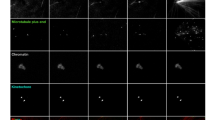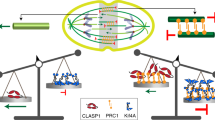Abstract
Microtubule organization is key to eukaryotic cell structure and function. In most animal cells, interphase microtubules organize around the centrosome, the major microtubule organizing centre (MTOC). Interphase microtubules can also become organized independently of a centrosome, but how acentrosomal microtubules arrays form and whether they are functionally equivalent to centrosomal arrays remains poorly understood1,2. Here, we show that the interphase microtubule arrays of fission yeast cells can persist independently of nuclear-associated MTOCs, including the spindle pole body (SPB) — the centrosomal equivalent. By artificially enucleating cells, we show that arrays can form de novo (self-organize) without nuclear-associated MTOCs, but require the microtubule nucleator mod20–mbo1–mto1 (refs 3–5), the bundling factor ase1 (refs 6,7), and the kinesin klp2 (refs 8,9). Microtubule arrays in enucleated and nucleated cells are morphologically indistinguishable and similarly locate to the cellular axis and centre. By simultaneously tracking nuclear-independent and SPB-associated microtubule arrays within individual nucleated cells, we show that both define the cell centre with comparable precision. We propose that in fission yeast, nuclear-independent, self-organized, acentrosomal microtubule arrays are structurally and functionally equivalent to centrosomal arrays.
This is a preview of subscription content, access via your institution
Access options
Subscribe to this journal
Receive 12 print issues and online access
$209.00 per year
only $17.42 per issue
Buy this article
- Purchase on SpringerLink
- Instant access to full article PDF
Prices may be subject to local taxes which are calculated during checkout




Similar content being viewed by others
References
Dammermann, A., Desai, A. & Oegema, K. The minus end in sight. Curr. Biol. 13, R614–R624 (2003).
Keating, T. J. & Borisy, G. G. Centrosomal and non-centrosomal microtubules. Biol. Cell 91, 321–329 (1999).
Samejima, I., Lourenco, P. C., Snaith, H. A. & Sawin, K. E. Fission yeast mto2p regulates microtubule nucleation by the centrosomin-related protein mto1p. Mol. Biol. Cell 16, 3040–3051 (2005).
Venkatram, S. et al. Identification and characterization of two novel proteins affecting fission yeast γ-tubulin complex function. Mol. Biol. Cell 15, 2287–2301 (2004).
Sawin, K. E., Lourenco, P. C. & Snaith, H. A. Microtubule nucleation at non-spindle pole body microtubule-organizing centers requires fission yeast centrosomin-related protein mod20p. Curr. Biol. 14, 763–775 (2004).
Yamashita, A., Sato, M., Fujita, A., Yamamoto, M. & Toda, T. The roles of fission yeast ase1 in mitotic cell division, meiotic nuclear oscillation, and cytokinesis checkpoint signaling. Mol. Biol Cell 16, 1378–1395 (2005).
Loiodice, I. et al. Ase1p organizes antiparallel microtubule arrays during interphase and mitosis in fission yeast. Mol. Biol Cell 16, 1756–1768 (2005).
Carazo-Salas, R. E., Antony, C. & Nurse, P. The kinesin Klp2 mediates polarization of interphase microtubules in fission yeast. Science 309, 297–300 (2005).
Troxell, C. L. et al. pkl1(+) and klp2(+): Two kinesins of the Kar3 subfamily in fission yeast perform different functions in both mitosis and meiosis. Mol. Biol Cell 12, 3476–3488 (2001).
Hayles, J. & Nurse, P. A journey into space. Nature Rev. Mol. Cell Biol. 2, 647–656 (2001).
Tran, P. T., Marsh, L., Doye, V., Inoue, S. & Chang, F. A mechanism for nuclear positioning in fission yeast based on microtubule pushing. J. Cell Biol. 153, 397–411 (2001).
Drummond, D. R. & Cross, R. A. Dynamics of interphase microtubules in Schizosaccharomyces pombe. Curr. Biol. 10, 766–775 (2000).
Ding, R., West, R. R., Morphew, D. M., Oakley, B. R. & McIntosh, J. R. The spindle pole body of Schizosaccharomyces pombe enters and leaves the nuclear envelope as the cell cycle proceeds. Mol. Biol. Cell 8, 1461–1479 (1997).
Janson, M. E., Setty, T. G., Paoletti, A. & Tran, P. T. Efficient formation of bipolar microtubule bundles requires microtubule-bound γ-tubulin complexes. J. Cell Biol. 169, 297–308 (2005).
Yamamoto, A., West, R. R., McIntosh, J. R. & Hiraoka, Y. A cytoplasmic dynein heavy chain is required for oscillatory nuclear movement of meiotic prophase and efficient meiotic recombination in fission yeast. J. Cell Biol. 145, 1233–1249 (1999).
West, R. R., Vaisberg, E. V., Ding, R., Nurse, P. & McIntosh, J. R. cut11(+): A gene required for cell cycle-dependent spindle pole body anchoring in the nuclear envelope and bipolar spindle formation in Schizosaccharomyces pombe. Mol. Biol. Cell 9, 2839–2855 (1998).
Daga, R. R. & Chang, F. Dynamic positioning of the fission yeast cell division plane. Proc. Natl Acad. Sci. USA 102, 8228–8232 (2005).
Brunner, D. & Nurse, P. CLIP170-like tip1p spatially organizes microtubular dynamics in fission yeast. Cell 102, 695–704 (2000).
Behrens, R. & Nurse, P. Roles of fission yeast tea1p in the localization of polarity factors and in organizing the microtubular cytoskeleton. J. Cell Biol. 157, 783–793 (2002).
Zheng, L., Schwartz, C., Wee, L. & Oliferenko, S. The fission yeast transforming acidic coiled coil-related protein Mia1p/Alp7p is required for formation and maintenance of persistent microtubule-organizing centers at the nuclear envelope. Mol. Biol. Cell 17, 2212–2222 (2006).
Mahoney, N. M., Goshima, G., Douglass, A. D. & Vale, R. D. Making microtubules and mitotic spindles in cells without functional centrosomes. Curr. Biol. 16, 564–569 (2006).
Reilein, A., Yamada, S. & Nelson, W. J. Self-organization of an acentrosomal microtubule network at the basal cortex of polarized epithelial cells. J. Cell Biol. 171, 845–855 (2005).
Malikov, V., Cytrynbaum, E. N., Kashina, A., Mogilner, A. & Rodionov, V. Centering of a radial microtubule array by translocation along microtubules spontaneously nucleated in the cytoplasm. Nature Cell Biol. 7, 1113–1118 (2005).
Acknowledgements
We thank E. Piddini, R. Daga, M. Pardo, M. Godinho-Ferreira, B. Novák, T. Surrey, M. Sato, T. Toda, F. Uhlmann and T. Wittmann, and members of the Nurse lab for discussions; O. Niwa, K. Sawin, and T. Toda for materials; and E. Piddini, T. Surrey, M. Godinho-Ferreira, O. Rog, J. Hayles, S. Castagnetti, F. Uhlmann and T. Wittmann for reading the manuscript. R.E.C.S. was supported by International Human Frontier Science Program (HFSP) and Cancer Research UK postdoctoral fellowships and P.N. was supported by Cancer Research UK and the Rockefeller University.
Author information
Authors and Affiliations
Corresponding author
Ethics declarations
Competing interests
The authors declare no competing financial interests.
Supplementary information
Supplementary Information
Supplementary figure S1 and supplementary table S1 (PDF 199 kb)
Rights and permissions
About this article
Cite this article
Carazo-Salas, R., Nurse, P. Self-organization of interphase microtubule arrays in fission yeast. Nat Cell Biol 8, 1102–1107 (2006). https://doi.org/10.1038/ncb1479
Received:
Accepted:
Published:
Issue Date:
DOI: https://doi.org/10.1038/ncb1479
This article is cited by
-
Spindles and active vortices in a model of confined filament-motor mixtures
BMC Biophysics (2011)
-
The kinesin-14 Klp2 organizes microtubules into parallel bundles by an ATP-dependent sorting mechanism
Nature Cell Biology (2009)
-
The 3Ms of central spindle assembly: microtubules, motors and MAPs
Nature Reviews Molecular Cell Biology (2009)
-
Force‐ and length‐dependent catastrophe activities explain interphase microtubule organization in fission yeast
Molecular Systems Biology (2009)
-
Force‐ and kinesin‐8‐dependent effects in the spatial regulation of fission yeast microtubule dynamics
Molecular Systems Biology (2009)



